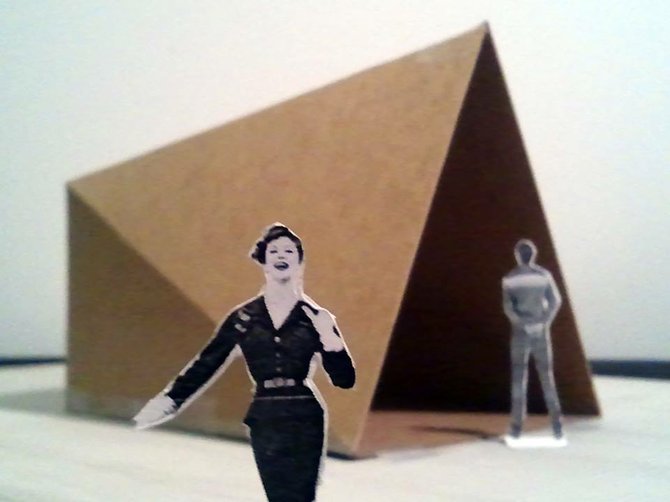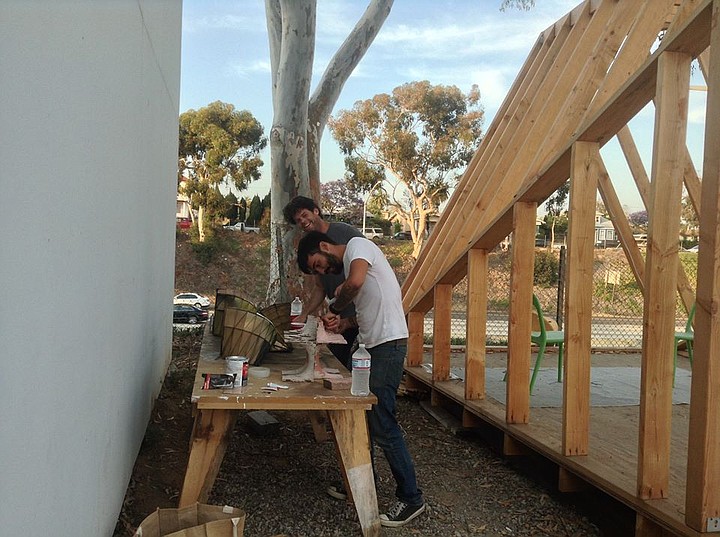 Facebook
Facebook
 X
X
 Instagram
Instagram
 TikTok
TikTok
 Youtube
Youtube

You may have seen it on a Barrio Logan hilltop just west of I-5: an electric-green trapezoid in an otherwise vacant lot, a triangular opening on one end and a larger square portal on the other. This is the Parasite, an experimental structure that leeches its power from the adjacent artist colony, La Esquina (2222 Logan Avenue), which is inhabited primarily by alumni and professors from the nearby Woodbury School of Architecture.
No larger than a parking spot, the Parasite was designed to remain within the parameters of a commercial storage space according to San Diego Municipal Code, thus avoiding costly permits. As such, the structure has no fixed foundation, does not exceed 12 feet in height, and occupies well under 400 square feet. Regulations also allow them to display and sell handcrafted products, artwork, and pottery, among other things.
“Before we worked on what ended up being the final shape, we were exploring a more vertical option,” says co-designer Jesus Limon. “The original design was actually about 20’ in height. It was going to have a mezzanine that you access through a ladder, and a terrace accessible through an operable skylight. We used to call it the ‘Urban Barn.’ Hector Perez, designer and owner of La Esquina, wanted to have a corn field on the site, but it never happened. We were going to provide the ‘Barn.’ This option was interesting but in order to avoid construction permits we decided to rethink the project.”
Because the Parasite is not fixed in its location, it can be easily transported to any space with the dimensions of a parking spot (9’x18’).
“It gives us the opportunity to have ownership without having any land and it enables us to be flexible in terms of location,” co-designer José Garcia says. “It is a gypsy.”

Limon and Garcia also designed the Parasite to be easily reproduced with a minimal investment, potentially creating the most affordable housing in the city.
“Previously, Jesus Limon and I were located in a very small office space in the University Heights and were used to having a minimal but efficient workspace,” says Garcia.
The Parasite now serves as a performance space for special events and the Barrio Art Crawl on the last Saturday of every month, but the designers may eventually make it an office space, mimicking the close quarters that they adapted to in University Heights.
“The Barrio is a very diverse neighborhood, where outsiders are seen with a suspicious eye,” Garcia says, “but the Parasite has managed to navigate under these conditions. Each new layer creates a new conversation which has ultimately brought the community to accept it. We have had people that see it from the freeway and come looking for it. We’ve even had a couple of contractors come into La Esquina, find our model, and say ‘that’s the thing that I always see from the freeway!’ Then we let them experience it for themselves.”
“We wanted the Parasite to be perceived as a strange object next to La Esquina,” Limon says. “The presence of the Parasite from the freeway and from the street needed to have a certain character. We were also concerned about harmony, composition, proportion, etc. We believe the final shape works perfectly with La Esquina. It completes it.”
They also took advantage of the Parasite’s odd geometry to frame a eucalyptus tree next to La Esquina in a gap between the two structures that is used as an outdoor workspace.
“We like clean, simple lines and simple geometry,” Limon says. “In the case of the Parasite and the ‘square to triangle shape solution,’ we wanted the object to be perceived as a single entity with no separation between walls and roof. Simple geometry, simple lines, simple form. The project has complexity in its content, but not necessarily in its form.”
“One of the challenges that we had with this project is the waterproofing and at the same time keeping the clean lines,” Limon continues. “We also wanted to be able to pick the color of the building. That meant no siding and no roofing materials. We tried a few ‘waterproofing paints’ on plywood but we didn’t get the desired results. Shrink wrapping was the solution. We painted the plywood the colors we selected, and we applied clear shrink wrap. This is a total experiment, since we don’t know how the material behaves over time. We are very happy with the looks though. At the end, I think it made sense to use electric greens. We are next to the freeway and it kind on blends with the freeway signs. This decision was more subconscious than anything else.”
On Saturday, August 30 from 7:30 to 10:30 p.m., the Parasite will host a free, transborder art and music event with Bulletproof Tiger (San Diego/El Paso four-on-the-floor dance party), I.O.B. (rare beats and sound collages from Tijuana), and selections by DJ O.J.
La Esquina residents David White and Patrick Shields will be showing their work which you can check out with a beer and a taco from Taco Victor for a buck each.
Summing up the strange marvel that is the Parasite, Limon says, “We like to overcome the limitations that building and municipal codes impose onto our profession and practice.”


You may have seen it on a Barrio Logan hilltop just west of I-5: an electric-green trapezoid in an otherwise vacant lot, a triangular opening on one end and a larger square portal on the other. This is the Parasite, an experimental structure that leeches its power from the adjacent artist colony, La Esquina (2222 Logan Avenue), which is inhabited primarily by alumni and professors from the nearby Woodbury School of Architecture.
No larger than a parking spot, the Parasite was designed to remain within the parameters of a commercial storage space according to San Diego Municipal Code, thus avoiding costly permits. As such, the structure has no fixed foundation, does not exceed 12 feet in height, and occupies well under 400 square feet. Regulations also allow them to display and sell handcrafted products, artwork, and pottery, among other things.
“Before we worked on what ended up being the final shape, we were exploring a more vertical option,” says co-designer Jesus Limon. “The original design was actually about 20’ in height. It was going to have a mezzanine that you access through a ladder, and a terrace accessible through an operable skylight. We used to call it the ‘Urban Barn.’ Hector Perez, designer and owner of La Esquina, wanted to have a corn field on the site, but it never happened. We were going to provide the ‘Barn.’ This option was interesting but in order to avoid construction permits we decided to rethink the project.”
Because the Parasite is not fixed in its location, it can be easily transported to any space with the dimensions of a parking spot (9’x18’).
“It gives us the opportunity to have ownership without having any land and it enables us to be flexible in terms of location,” co-designer José Garcia says. “It is a gypsy.”

Limon and Garcia also designed the Parasite to be easily reproduced with a minimal investment, potentially creating the most affordable housing in the city.
“Previously, Jesus Limon and I were located in a very small office space in the University Heights and were used to having a minimal but efficient workspace,” says Garcia.
The Parasite now serves as a performance space for special events and the Barrio Art Crawl on the last Saturday of every month, but the designers may eventually make it an office space, mimicking the close quarters that they adapted to in University Heights.
“The Barrio is a very diverse neighborhood, where outsiders are seen with a suspicious eye,” Garcia says, “but the Parasite has managed to navigate under these conditions. Each new layer creates a new conversation which has ultimately brought the community to accept it. We have had people that see it from the freeway and come looking for it. We’ve even had a couple of contractors come into La Esquina, find our model, and say ‘that’s the thing that I always see from the freeway!’ Then we let them experience it for themselves.”
“We wanted the Parasite to be perceived as a strange object next to La Esquina,” Limon says. “The presence of the Parasite from the freeway and from the street needed to have a certain character. We were also concerned about harmony, composition, proportion, etc. We believe the final shape works perfectly with La Esquina. It completes it.”
They also took advantage of the Parasite’s odd geometry to frame a eucalyptus tree next to La Esquina in a gap between the two structures that is used as an outdoor workspace.
“We like clean, simple lines and simple geometry,” Limon says. “In the case of the Parasite and the ‘square to triangle shape solution,’ we wanted the object to be perceived as a single entity with no separation between walls and roof. Simple geometry, simple lines, simple form. The project has complexity in its content, but not necessarily in its form.”
“One of the challenges that we had with this project is the waterproofing and at the same time keeping the clean lines,” Limon continues. “We also wanted to be able to pick the color of the building. That meant no siding and no roofing materials. We tried a few ‘waterproofing paints’ on plywood but we didn’t get the desired results. Shrink wrapping was the solution. We painted the plywood the colors we selected, and we applied clear shrink wrap. This is a total experiment, since we don’t know how the material behaves over time. We are very happy with the looks though. At the end, I think it made sense to use electric greens. We are next to the freeway and it kind on blends with the freeway signs. This decision was more subconscious than anything else.”
On Saturday, August 30 from 7:30 to 10:30 p.m., the Parasite will host a free, transborder art and music event with Bulletproof Tiger (San Diego/El Paso four-on-the-floor dance party), I.O.B. (rare beats and sound collages from Tijuana), and selections by DJ O.J.
La Esquina residents David White and Patrick Shields will be showing their work which you can check out with a beer and a taco from Taco Victor for a buck each.
Summing up the strange marvel that is the Parasite, Limon says, “We like to overcome the limitations that building and municipal codes impose onto our profession and practice.”
Comments